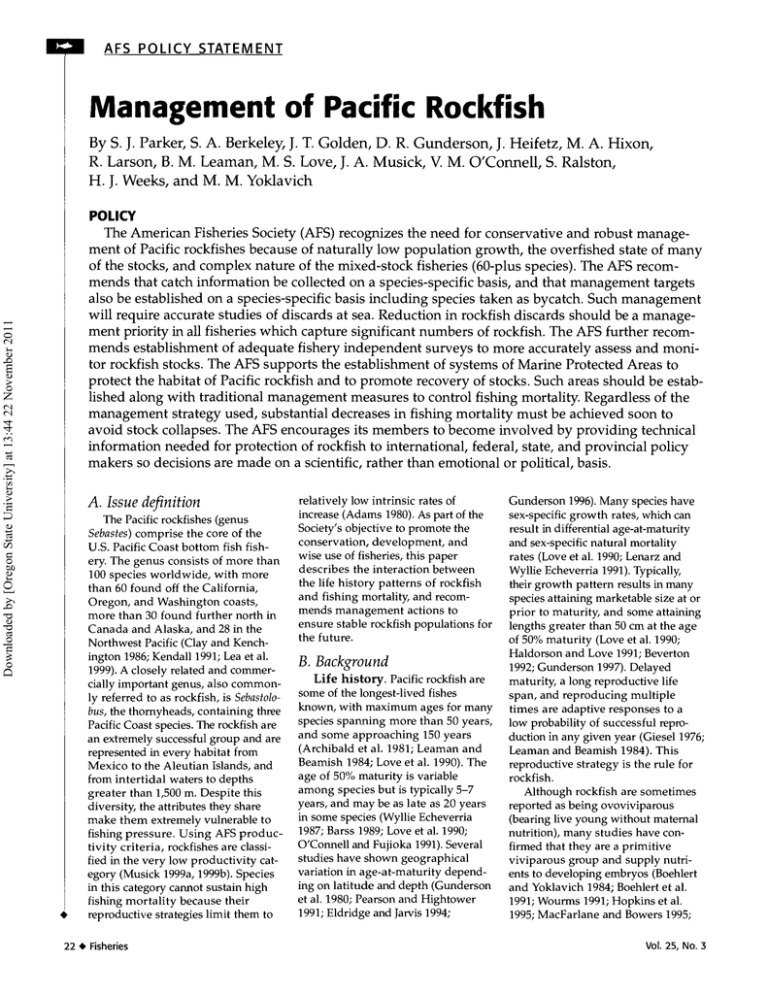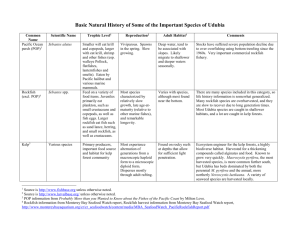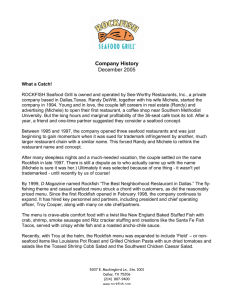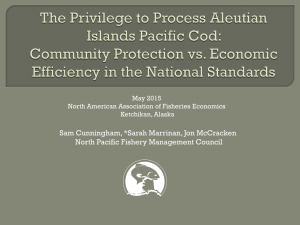Management of Pacific Rockfish
advertisement

1_ I ACC _ r nIIiv r -LIL rv I CTATI-r'AcIT cLIVILcl III I Management of Pacific Rockfish Downloaded by [Oregon State University] at 13:44 22 November 2011 By S. J. Parker, S. A. Berkeley, J. T. Golden, D. R. Gunderson, J. Heifetz, M. A. Hixon, R. Larson, B. M. Leaman, M. S. Love, J. A. Musick, V. M. O'Connell, S. Ralston, H. J. Weeks, and M. M. Yoklavich POLICY The American Fisheries Society (AFS) recognizes the need for conservative and robust management of Pacific rockfishes because of naturally low population growth, the overfished state of many of the stocks, and complex nature of the mixed-stock fisheries (60-plus species). The AFS recommends that catch information be collected on a species-specific basis, and that management targets also be established on a species-specific basis including species taken as bycatch. Such management will require accurate studies of discards at sea. Reduction in rockfish discards should be a management priority in all fisheries which capture significant numbers of rockfish. The AFS further recommends establishment of adequate fishery independent surveys to more accurately assess and monitor rockfish stocks. The AFS supports the establishment of systems of Marine Protected Areas to protect the habitat of Pacific rockfish and to promote recovery of stocks. Such areas should be established along with traditional management measures to control fishing mortality. Regardless of the management strategy used, substantial decreases in fishing mortality must be achieved soon to avoid stock collapses. The AFS encourages its members to become involved by providing technical information needed for protection of rockfish to international, federal, state, and provincial policy makers so decisions are made on a scientific, rather than emotional or political, basis. A. Issue definition The Pacific rockfishes (genus Sebastes) comprise the core of the U.S. Pacific Coast bottom fish fishery. The genus consists of more than 100 species worldwide, with more than 60 found off the California, Oregon, and Washington coasts, more than 30 found further north in Canada and Alaska, and 28 in the Northwest Pacific (Clay and Kenchington 1986; Kendall 1991; Lea et al. 1999). A closely related and commercially important genus, also commonly referred to as rockfish, is Sebastolobus, the thornyheads, containing three Pacific Coast species. The rockfish are an extremely successful group and are represented in every habitat from Mexico to the Aleutian Islands, and from intertidal waters to depths greater than 1,500 m. Despite this diversity, the attributes they share make them extremely vulnerable to fishing pressure. Using AFS productivity criteria, rockfishes are classified in the very low productivity category (Musick 1999a, 1999b). Species in this category cannot sustain high fishing mortality because their reproductive strategies limit them to 22 * Fisheries relatively low intrinsic rates of increase (Adams 1980). As part of the Society's objective to promote the conservation, development, and wise use of fisheries, this paper describes the interaction between the life history patterns of rockfish and fishing mortality, and recommends management actions to ensure stable rockfish populations for the future. B. Background Life history. Pacific rockfish are some of the longest-lived fishes known, with maximum ages for many species spanning more than 50 years, and some approaching 150 years (Archibald et al. 1981; Leaman and Beamish 1984; Love et al. 1990). The age of 50% maturity is variable among species but is typically 5-7 years, and may be as late as 20 years in some species (Wyllie Echeverria 1987; Barss 1989; Love et al. 1990; O'Connell and Fujioka 1991). Several studies have shown geographical variation in age-at-maturity depending on latitude and depth (Gunderson et al. 1980; Pearson and Hightower 1991; Eldridge and Jarvis 1994; Gunderson 1996). Many species have sex-specific growth rates, which can result in differential age-at-maturity and sex-specific natural mortality rates (Love et al. 1990; Lenarz and Wyllie Echeverria 1991). Typically, their growth pattern results in many species attaining marketable size at or prior to maturity, and some attaining lengths greater than 50 cm at the age of 50% maturity (Love et al. 1990; Haldorson and Love 1991; Beverton 1992; Gunderson 1997). Delayed maturity, a long reproductive life span, and reproducing multiple times are adaptive responses to a low probability of successful reproduction in any given year (Giesel 1976; Leaman and Beamish 1984). This reproductive strategy is the rule for rockfish. Although rockfish are sometimes reported as being ovoviviparous (bearing live young without maternal nutrition), many studies have confirmed that they are a primitive viviparous group and supply nutrients to developing embryos (Boehlert and Yoklavich 1984; Boehlert et al. 1991; Wourms 1991; Hopkins et al. 1995; MacFarlane and Bowers 1995; Vol. 25, No. 3 ArC Downloaded by [Oregon State University] at 13:44 22 November 2011 Mr3 Beckmann et al. 1998). The number of eggs produced at the 50% maturity age commonly range from 2,000 to 500,000 eggs per year, with maximumlength individuals of some species producing several million eggs (Gunderson et al. 1980; Love et al. 1990; Haldorson and Love 1991). Most species copulate in the fall, but sperm may be stored and fertilization may not take place until several weeks later (Wyllie Echeverria 1987; Love et al. 1990). An exception is in the Sebastolobus genus where buoyant, egg masses are released and fertilization is believed to be external (Pearcy 1962; Erickson and Pikitch 1993). Copulation has been observed in very few species of Sebastes, so little is known about courtship or mating behavior (Helvey 1982; Shinomiya and Ezaki 1991; Gingras et al. 1998). The female retains the embryos for 4-5 weeks until hatching (Boehlert and Yoklavich 1984), and parturition generally occurs in winter or spring for more southerly populations and spring or summer in northerly populations (O'Connell 1987; Yoklavich et al. 1996). In most species, reproduction occurs annually, but the production of multiple broods occurs in some species and may be related to environmental conditions (Wyllie Echeverria 1987; Love et al. 1990). Generally, the larvae are found in the upper mixed zone of the ocean for a variable period of time, before metamorphosing into juveniles, which move closer to shore as they grow during the spring months (Larson et al. 1994). After several more months, juveniles of many species move to deeper adult habitats (Love et al. 1998a). Adults are typically associated with structure, though some species are found on flat muddy bottoms and others are semi-pelagic (Richards 1986; Matthews 1991; O'Connell and Carlile 1993; Krieger 1998). Some closely related species are segregated spatially at the scale of microhabitats (Larson 1980; Hallacher and Roberts 1985; Leaman 1991; Stein et al. 1992; Murie et al. 1993). As adults, rockfish are thought to be relatively sedentary, though some species may make considerable movements (Pearcy 1992; Lea et al. 1999). Tagging studies to observe movement patterns are confounded because rockMarch 2000 fish possess well-developed swim bladders and are subject to embolism, so many do not survive being brought to the surface. However, some investigators have deflated rockfish swimbladders prior to tagging, or used in situ tagging, thus increasing survivorship. These studies demonstrated that some species show site fidelity and some ability to home after minor displacements, though some have shown substantial movements (Mathews and Barker 1983; O'Connell 1991; Pearcy 1992; Stanely et al. 1994; Carlson et al. 1995). Species-specific movements depend on latitude, and oceanographic conditions (Leaman 1991). Relatively poor ocean conditions for the past two decades may have reduced recruitment success in some California-Oregon species (Ralston and Howard 1995). In contrast, in waters off Alaska and northern British Columbia above average recruitment has occurred in recent years for some rockfish species (e.g., Pacific ocean perch, Sebastes alutus) (Richards and Olsen 1996; Heifetz et al. 1999). A dominant feature of rockfish reproduction is a pattern of infrequent and irregular years with successful recruitment during periods with favorable environmental conditions, and many years with poor recruitment (Leaman and Beamish 1984; Botsford et al. 1994; Ralston and Howard 1995). However, an entire year class may not experience favorable environmental conditions because of variation in the timing of larval release. Recent research by Berkeley and Markle (1999) has shown that older black rockfish (S. melanops) release larvae earlier in the season followed by progressively younger fish, and that successful recruitment may come from a relatively restricted time period within the spawning season. This pattern has also been observed in darkblotched rockfish (S. crameri) (Nichol and Pikitch 1994) and yellowtail rockfish (S.flavidus) (Eldridge et al. 1991). In another study, Larson et al. (1998) found that recruits of shortbelly rockfish (S. jordani) exhibited reduced genetic variability compared to the adult population, suggesting that surviving young of the year are the products of reproduction by only a small fraction of the adult population. nlf rLIL rV ,I CT1 TATTCVI 3 II LIVICI I Reproductive success appears then to be restricted to narrow spatial and temporal windows when conditions are favorable for larval survival. Although many general life history traits are known for the Sebastes genus, few species have been studied in detail (Moser 1967; Leaman 1991, Love et al. 1998b). This is another common theme with rockfish: a lack of stock status and biological information, especially on commercially exploited species. Basic parameters such as maximum age, natural mortality rates, fecundity, and age at maturity have only been measured for a limited number of the exploited species, especially the diverse near-shore species (Love et al. 1990). Even for many commercially harvested species, much needed information concerning stock identification, genetic diversity, spawning behavior, bycatch levels, total removals, and migration patterns are not known or are based on limited data from small geographic areas. Fishery history and status. Washington, Oregon, and California waters. Rockfish have been commercially harvested since the mid-1800s in California, but not until the 1940s along much of the northwest coast (Lenarz 1987). In the mid-1960s, foreign factory trawlers targeted Pacific ocean perch, with annual catches exceeding 20,000 metric tons (mt) until passage of the Magnuson-Stevens Fishery Conservation and Management Act in 1976 (Ianelli and Zimmerman 1998). Currently, rockfish are harvested mainly with bottom trawl gear (89%), with other gears used especially near shore and in high relief areas (hook and line (9%) and other gears (2%)) (PacFIN 1999a; PacFIN 1999b). Recreational catches have been decreasing steadily from 8,000 mt in the early 1980s, and have recently amounted to near 2,000 mt (PFMC) 1999). Much of the recreational harvest has been focused on nearshore species such as black rockfish, blue rockfish (S. mystinus), and copper rockfish (S. caurinus) (RecFIN database 2000, Pacific States Marine Fisheries Commission, Gladstone, OR). For these species and other nearshore species, recreational harvest is much greater than commercial harvest and has had dramatic impacts on population abundance Fisheries * 23 _IR· Il AFS POLICY STATEMENT Downloaded by [Oregon State University] at 13:44 22 November 2011 and structure, especially in California (Love et al. 1998b; Mason 1998). Typically, the Pacific Fishery Management Council (PFMC) sets optimum yield recommendations for the WashingtonOregon-California region on an annual basis for individual species or species complexes, and regulates their harvest (including discard) through the use of quotas, trip limits, gear restrictions, and time/area closures, to ensure a yearround fishery (PFMC 1993; Ralston 1998). Total harvest of rockfish in the Washington-California management area ranged between 22,000-50,000 mt o ua It is expected that the PFMC will institute rebuilding plans for canary rockfish (Sebastes pinniger) in 2000. during the 1990s, and has been steadily decreasing throughout the decade (PFMC 1999). The catch has been worth more than $30,000,000 annually (PFMC 1999). Data on the harvest of individual species are limited because many species are categorized as "near-shore," "shelf," and "slope" complexes for management purposes (PFMC 1999). Estimates of species composition are dependent on sub-sampling of a variable number of trips among the ports (Sampson et al. 1997). In recent years, a rapidly growing live-fish fishery (fish marketed alive) has developed in California and Oregon, placing new commercial fishing pressure on nearshore rockfish species traditionally harvested in the recreational fishery, such as China rockfish (S. nebulosus) and grass rockfish (S. rastrelliger)(Love and Johnson 1998; Bloeser 1999; W. H. Barss, Oregon Department of Fish and Wildlife, Newport, pers. comm.). Of the 54 species of rockfish that are commercially harvested and managed by PFMC, only 10 have had full stock 24 * Fisheries assessments (Ralston 1998; NMFS 1999a, PFMC 1999). Only 1 of 12 near-shore rockfish species impacted by commercial live-fish and recreational fisheries has been fully assessed. Of those that have full assessments, 5 of 10 are considered above or near target biomass, 1 is below the target, and 4 are overfished (less than 25% of original stock biomass). The implementation of the Sustainable Fisheries Act of 1996 now requires rebuilding plans for stocks identified as overfished and includes decreases in fishing mortality. In 1999, the PFMC instituted rebuilding plans for bocaccio (S. paucispinis), and Pacific ocean perch, which were at levels of 2%, and 13% of the estimated "virgin" biomass (PFMC 1999). It is expected that rebuilding plans for canary rockfish (S. pinniger)and cowcod (S. levis) will be instituted in 2000 (PFMC 1999). The standard management scheme for rockfish off the U.S. coast has been to manage for a fishing mortality of F4 0 %, as a rate that will approach the maximum sustainable yield. This rate is defined as the fishing mortality that reduces the spawning potential per recruit to 40% of the unfished condition (Clark 1993). New evaluations of this fishing rate question this target based on the particular life-history constraints of each species (Ralston 1999). Evidence has accumulated for substantial declines in the abundance of many species of rockfish from Washington to California (Gunderson 1996; Ralston 1998; Love et al. 1998a; Love et al. 1998b; PFMC 1999). These studies and fishery independent surveys have tracked juvenile abundance, recreational harvest, and commercial harvest over the past 15-20 years and show dramatic declining trends of abundance. The impacts of the developing live-fish fishery on near-shore rockfish species in addition to the normal recreational harvest are unknown because the status of most of these species has never been assessed (Love and Johnson 1998). Because the largest, oldest, most fecund individuals are selectively captured as fisheries intensify, age distributions have become truncated with the loss of significant spawning biomass and a distinct segment of the population that may determine recruitment success in some years (Berkeley and Markle 1999). For example, large decreases in the biomass of large, hence old, females and a corresponding decrease in mean age has been documented for black rockfish, canary rockfish, and Pacific ocean perch, among others (Gunderson 1977; Love et al. 1998b; Berkeley and Markle 1999). Given that rockfish are categorized as very low productivity species using AFS criteria, many of these species would now be listed as vulnerable and warrant further consideration for protection (Musick 1999a). Indeed, the brown rockfish (S. auriculatus),copper rockfish, and quillback rockfish (S. maliger) of Puget Sound are under status review for listing under the Endangered Species Act (NMFS 1999b). An additional 11 rockfish species from Puget Sound are not under review because of insufficient information on stock identification and species-specific trends in abundance. One of the main obstacles in harvest management of rockfish has been the accurate assessment of bycatch. Even with conservative harvest limits, rockfish are captured at significant levels in many different fisheries. Discard levels for rockfish vary with a number of factors but are estimated at usually between 15% and 30% of the catch (PFMC 1997). Much of the discard is a result of the management approach (species-specific or assemblage groups with trip or period landing limits), other regulations (such as gear characteristics), and market conditions (Pikitch et al. 1988). Actual levels are not known because no observer program exists to document bycatch and discard. Some species are not marketed at all, and most are only marketable after exceeding 30 cm in length, resulting in undocumented discard for almost all species captured. Because most are dead or moribund at capture, mortality rates of discarded rockfish approach 100%. The mortality rate for those entrained in trawls but escaping because of their small size has not been estimated. With no accurate levels of bycatch available, there is little confidence in total harvest levels or in harvest composition for many rockfish fisheries. Vol. 25, No. 3 Downloaded by [Oregon State University] at 13:44 22 November 2011 AFS POLICY STATEMENT Alaskan waters. Rockfish have been commercially harvested off of Alaska since the early 1900s, but in the early 1960s a massive Pacific ocean perch trawl fishery by the U.S.S.R. and Japan rapidly developed. Catches peaked in the mid 1960s, when a total of nearly 500,000 mt were caught off of Alaska (Heifetz et al. 1999; Ito et al. 1999). This apparent overfishing resulted in a precipitous decline in catches in the late 1960s, which continued through the 1970s. By the mid-1980s catches were less than 10,000 mt. A similar trend occurred off Canada, with peak catches of about 66,000 mt in 1966 followed by a steep decline thereafter (Westrheim 1987). Currently, the largest fisheries off the Pacific Coast occur in Alaska with a total catch of rockfish of about 42,200 mt in 1999 (NPFMC 1999). Historically, bottom trawls have accounted for most of the commercial harvest of rockfish, though a sizeable portion is also captured by longline. Recently, pelagic trawls have been used for Pacific ocean perch, and black rockfish have been taken mostly by jig gear. Life history and stock status information is lacking for many species of rockfish managed in Alaskan waters as well. The North Pacific Fishery Management Council (NPFMC) categorizes the information available on each stock into one of six tiers. Stocks categorized in tiers 1 through 3 are comparable to PMFC stocks with full assessments (Pacific ocean perch and thornyheads are the only 2 of 32 species of rockfish with this level of information) (NPFMC 1999). However, the NPFMC has taken a conservative approach to rockfish management and no species are considered overfished in the waters of Alaska. Since 1988 in this region, the rockfish have been divided into management assemblages based on their habitat, distribution, and commercial catch composition. Beginning in 1991, the NPFMC divided the assemblages into several subgroups; established to protect the most sought-after commercial species in the assemblage from possible overfishing. The NPFMC sets annual harvest levels for each management group after considering factors such as economics and bycatch. These harvest levels are typically less than or equal to the maximum allowable levels based on species- or assemblage-specific stock March 2000 assessments. Even with low harvest rate impose on the population's ability to recover from reductions in abundance strategies however, sedentary and spatially isolated species such as yelloweye (Giesel 1976; Leaman 1991). Long-term sustainability requires the use of the rockfish (S. ruberrimus) and shortraker precautionary principle when setting rockfish (S. borealis) require a spatial and estimating fishing mortality (Botscomponent added to management to ford et al. 1997; Dayton 1998). The necprevent localized depletion (O'Connell essary management action must be to et al. 1999). decrease fishing mortality to restore The NPFMC and the Alaska Department of Fish and Game regulate the population stability, structure, and diversity. This means that management harvest (including discard) through the use of time/area closures and maxishould consider not just the magnitude mum allowable bycatch restrictions to of fishing mortality, but how it is distributed spatially and demographically ensure that area-specific total mortality as well. With these goals, fishing morlevels are not exceeded. A mandatory tality can be reduced and managed observer program for vessels greater through a number of diverse, yet comthan 60 ft in length has been in place plementary actions. No single action is since early 1990s to collect biological robust to human error or ingenuity, so data and provide data critical for estimating discard rates and total mortaliall management actions must be implemented in concert and with constant ty for individual rockfish species. evaluation and enforcement. ObviousOther management measures that may have provided some benefit to ly, a direct reduction in total mortality is needed given the reproductive conrockfish have included a trawl ban in straints of rockfishes and the status of the Eastern Gulf of Alaska and a rebuilding plan for Pacific ocean perch many of the assessed species. Along (Ianelli and Heifetz 1995). The NPFMC with lower harvest levels, changes in recently passed an amendment to rethe quota management system (e.g., use quire full retention of demersal shelf of low trip limits, short fishing periods, rockfish, allowing sale of bycatch up a year round fishery) must occur to to the allowable bycatch rate with the decrease or eliminate regulatoryremainder of fish forfeited to the state. induced discard, and observe the byThe Alaska Board of Fisheries is consid- catch and discard that does occur. Given the uncertainties associated with ering similar regulations for all rockfish species taken in state-managed stock assessment and the mixed-species fisheries. Efforts are also underway to nature of rockfish fisheries, regulating landings through trip limits and estiexplore alternative methods to assess rockfish abundance because of probmating bycatch while ensuring an adelems associated with current trawl surquate stock size for recovery could vey methodology (Heifetz et al. 1999; result in extremely low or only incidenQuinn et al. 1999). tal harvest levels for some species that Management approach. Manageare not overfished. This is essentially ment of Pacific rockfishes has been complicated and n g slow at best in its adaptation to new 01; information (Leaman 1991; Ralston 1998). Populations at have shown little response to the on management meaos sures used to date, mostly because these measures fail to consider the constraints that reproductive strate- The quillback rockfish (S.maliger) is under status review for listing under the Endangered dSpecies Act. gies of rockfish Fisheries * 25 Downloaded by [Oregon State University] at 13:44 22 November 2011 AFS POLICY STATEMENT the approach that the PFMC took in their rebuilding plans for bocaccio and Pacific ocean perch; with similar actions planned for canary rockfish and cowcod in 2000 (PFMC 1999). Another aspect of a diverse management plan is to reduce fishing effort through a decrease in the number of vessels or a decrease in fishing time. Although the efficiency of remaining vessels can increase through time, a substantial reduction in vessels would quickly reduce effort and decrease regulatory-induced discard because fewer trips would be made when approaching a harvest period limit or a vessel's limit for a target species. Some efforts are underway from within the fishing industry to reduce the size of the fleet to a more sustainable number of vessels and to train fishers for careers in other areas. In addition to reduced harvest rates, a significant portion of each population and its habitat must be protected in notake reserves or Marine Protected Areas (MPAs), where populations may be protected from harvest of any kind (Murray et al. 1999). Marine protected areas can be used to protect ecosystem structure and function, increase scientific understanding of management actions, and enhance non-extractive activities, while benefiting fish populations (Lauck et al. 1998; Hall 1998; Murray et al. 1999). Several small marine reserves currently exist in California and Washington, but these were not designed for use as commercial fishery refuges (McArdle 1998; Palsson 1998). However, evaluations of these approaches, and models of MPA systems in Alaska appear to show promise for rockfish populations (Soh et al. 1998). An effective system of MPAs must consider the ecology and community structure of those species to be protected as well as the dynamics of the entire ecosystem. For example, Walters and Bonfil (1999) showed that the mobility of some species could reduce the protection afforded by MPAs. However, it is generally recognized that we have sufficient understanding of the management problems associated with many species of rockfish to design and implement effective MPAs (Yoklavich 1998). To be effective, these systems must be designed to meet specific goals and undergo intensive periodic evaluations to measure the ecosystem response 26 * Fisheries (Allison et al. 1998; Roberts 1998; Starr 1998). Evaluation of MPA effectiveness will require intensive sampling and habitat evaluation of the reserve area as well as adjacent areas for comparison. Because implementing MPAs will not have immediate effects at the ecosystem level, sampling and evaluation will need to occur for a significant period of time (starting prior to MPA implementation) and requires a long term commitment for success (Carr and Reed 1993; Palsson 1998). Conclusion. Several life history characteristics of Pacific rockfish require that they be managed more conservatively than most marine fishes. Applying the precautionary principle to these species will require decreases in fishing mortality rates and management strategies that protect the physical habitat, allow for a full complement of age classes, and prevent recruitment overfishing throughout the entire geographic range of the stock. Uncertainty associated with actual harvest levels, spawning biomass, and annual recruitment must be buffered with conservation measures such as reduced fishing mortality, long-term species-specific monitoring, habitat protection, and protection of a significant portion of the population through the use of appropriately designed MPAs (Lauck et al. 1998). The population dynamics of rockfishes require that these management actions be taken quickly, but as part of a multifaceted adaptive management framework to have the greatest potential to address these issues while allowing a significant mixed-species fishery to continue. C. Needed actions The AFS recognizes the need for conservative management of the Pacific rockfishes because of the low rebound potentials and over-fished state of many of the species and complex nature of the mixed-species fisheries (60-plus species). The end result must be robust to uncertainty with a low fishing mortality on each species, dictated by the biological constraint of a limited and unpredictable ability for population growth. Because large changes in management strategy will take time, both to implement and to have effects, we recommend reductions in fishing mortality through changes in the current management system, as well as the development of MPAs for use as supplemental fisheries management tools as follows. * Reduce fishing mortality by establishing reduced harvest levels and designing management systems to reduce bycatch and discard. * Determine total mortalities by species, including mortalities associated with recreational and subsistence fishing to allow the total catch of each species to be monitored with high confidence. * Establish mechanisms to limit harvest to the targets established each year, and set limits for each species, not groups of species, where weak stocks can be overfished. * Collect species-specific information on age, maturity, fecundity, location and conditions of capture. Baseline data collection on unexploited species should begin before major fisheries develop. * Document and monitor bycatch and discard rates at sea to calculate accurate estimates of fishing mortality. Develop mechanisms to reduce the bycatch of rockfish in non-rockfish fisheries, and to reduce the capture of unmarketable sizes or species in all fisheries. * Establish adequate fishery independent surveys and develop new survey techniques to monitor population abundance and promote accurate stock assessments. * Managers should buffer fishing pressure against variability in stock recruitment levels and unforeseen fishing mortality effects by protecting a portion of each population and its habitat through the use of marine protected areas. Experimental marine protected areas should be implemented as part of an adaptive management framework to develop effective criteria for conserving rockfish populations. They should be designed to protect multiple species, their habitats, demographic and genetic structure, and community structure. * In addition to reductions in fishing mortality through direct reductions in catch and through population protection, decreases in fishing effort must occur. Therefore, managers should immediately implement programs that effectively reduce fishing effort, such as fleet-size reduction, Vol. 25, No. 3 AFS POLICY STATEMENT Downloaded by [Oregon State University] at 13:44 22 November 2011 training for alternative careers, and community assistance programs. * All of these recommendations require substantial effort and infrastructure for implementation and evaluation. The AFS recommends high priority for funding of research and management activities necessary to ensure stable Pacific rockfish populations in the future. )_ S. J. Parker is a researchfisheries biologistfor the Oregon Department of Fish and Wildlife (ODFW) Marine Resources Program in Newport. S. A. Berkeley isfaculty research assistant at the Hatfield Marine Science Center in Newport, Oregon. He is also president of the AFS Marine Fisheries Section. J. T. Golden is a resource assessment and analysis program managerforthe ODFW Marine Resources Program in Newport. D. R. Gunderson is a professor in the School of Fisheries at the University of Washington in Seattle. J. Heifetz is a fishery research biologist at the National Marine Fisheries Service (NMFS) Auke Bay, Alaska, laboratory.M. A. Hixon is a professor of marine ecology in the Department of Zoology at Oregon State University in Corvallis. R. Larson is a professor in the Department of Biology at San Francisco State University in California. B. M. Leaman is executive director of the International Pacific Halibut Commission in Seattle, Washington. M. S. Love is an associate research biologist in the Marine Science Institute at the University of Californiain Santa Barbara.J. A. Musick is head of Vertebrate Ecology and Systematics programs at the Virginia Institute of Marine Science in Gloucester Point; V. M. O'Connell is Groundfish Project leader at the Alaska Department of Fish and Game in Sitka. S. Ralston is at the NMFS Tiburon, California, laboratory. H. I. Weeks is extension facultyfor marinefisheriesat Oregon State University Sea Grant Extension in Newport. M. M. Yoklavich is a researchfishery biologist at the NMFS Long Marine Laboratory in Santa Cruz, California. This article represents the views of the American Fisheries Society and not necessarily the authors' organizations or agencies. References Adams, P. B. 1980. Life history patterns in marine fishes and their consequences for fisheries management. Fish. Bull. 78:1-12. Allison, G. W., J. Lubchenco, and M. H. Carr. 1998. Marine reserves are March 2000 necessary but not sufficient for marine conservation. Ecol. Appl. 8(Supplement): S79-S92. Archibald, C. P., W. Shaw, and B. M. Leaman. 1981. Growth and mortality estimates of rockfishes (Scorpaenidae) from B.C. coastal waters 1977-1979. Can. Tech. Rep. Fish. Aquat. Sci. 1048. Barss, W. H. 1989. Maturity and reproductive cycle for 35 species from the Family Scorpaenidae found off Oregon. Oregon Department of Fish and Wildlife Information Report, 89-7, Portland. Beckmann, A. T., D. R. Gunderson, B. S. Miller, R. M. Buckley, and B. Goetz. 1998. Reproductive biology, growth, and natural mortality of Puget Sound rockfish, Sebastes emphaeus (Starks 1911). Fish. Bull. 96(2):352-356. Berkeley, S. A., and D. Markle. 1999. Effects of fishing-induced age truncation on recruitment and reproductive potential in black rockfish (Sebastes melanops). Final report to Oregon Sea Grant, R/OPF-46, Corvallis. Beverton, R. J. H. 1992. Patterns of reproductive strategy parameters in some marine teleost fishes. J. Fish. Biol. 41:137-160. Bloeser, J. 1999. Diminishing returns: the status of West Coast groundfish. Pacific Marine Conservation Council, Astoria, OR. Boehlert, G. W., and M. M. Yoklavich. 1984. Reproduction, embryonic energetics, and the maternal-fetal relationship in the viviparous genus Sebastes (Pisces: Scorpaenidae). Biol. Bull. (Woods Hole) 167:354-370. Boehlert, G. W., M. S. Love, J. P. Wourms, and J. Yamada. 1991. A summary of the symposium on rockfishes and recommendations for future research. Environ. Biol. Fish. 30:273-280. Botsford, L. W., C. L. Moloney, A. Hastings, J. L. Largier, T. M. Powell, K. Higgins, and J. E Quinn. 1994. The influence of spatially and temporally varying oceanographic conditions on meroplanktonic metapopulations. Deep-Sea Res. Part II: Top. Stud. Oceanogr. 41:107-145. Botsford, L. W., J. C. Castilla, and C. H. Peterson. 1997. The management of fisheries and marine ecosystems. Science 277:509-515. Carlson, H. R., R. E. Haight, and J. H. Helle. 1995. Initial behavior of displaced yellowtail rockfish Sebastes flavidus in Lynn Canal, Southeast Alaska. Alaska Fish. Res. Bull. 2(1):76-80. Carr, M. H., and D. C. Reed. 1993. Conceptual issues relevant to marine harvest refuges: examples from temperate reef fishes. Can. J. Fish. Aquat. Sci. 50:2019-2028. Clark, W. G. 1993. The effect of recruitment variability on the choice of a target level of spawning biomass per recruit. Pages 233-246 in Proceedings of the international symposium on management strategies for exploited fish populations. Alaska Sea Grant College Program, AK-SG-93-02, Anchorage. Clay, D., and T. J. Kenchington. 1986. World bibliography of the redfishes and rockfishes (Sebastinae, Scorpaenidae). Can. Tech. Rep. Fish. Aquat. Sci. 1429. Dayton, P. K. 1998. Reversal of the burden of proof in fisheries management. Science 279:821-822. Eldridge, M. B., and B. M. Jarvis. 1994. Temporal and spatial variation in fecundity of yellowtail rockfish. Trans. Am. Fish. Soc. 124(1):16-25. Eldridge, M. B., J. A. Whipple, M. J. Bowers, B. M. Jarvis, and J. Gold. 1991. Reproductive performance of yellowtail rockfish, Sebastesflavidus. Environ. Biol. Fish. 30:91-102. Erickson, D. L., and E. K. Pikitch. 1993. A histological description of the shortspine thornyhead, Sebastolobusalascanus, ovaries: structures associated with the production of gelatinous egg masses. Environ. Biol. Fish. 36:273-282. Giesel, J.T. 1976. Reproductive strategies as adaptations to life in temporally heterogeneous environments. Annu. Rev. Ecol. Syst. 7:57-79. Gingras, M. L., D. A. Ventresca, M. D. Donnellan, and J. L. Fisher. 1998. First observations of vermillion rockfish courtship are from a harvest refuge. Calif. Fish. Game 84(4):176-179. Gunderson, D. R. 1977. Population biology of Pacific Ocean perch, Sebastes alutus, stocks in the Washington-Queen Charlotte Sound region, and their response to fishing. Fish. Bull. 75(2):369-403. Gunderson, D. R. 1996. Spatial patterns in the dynamics of slope rockfish stocks and their implications for management. Fish. Bull. 95:219-230. -____. 1997. Trade-off between reproductive effort and adult survival in oviparous and viviparous fishes. Can. J. Fish. Aquat. Sci. 54:990-998. Gunderson, D.R., P.Callahan, and B. Goiney. 1980. Maturation and fecundity of four species of Sebastes. Mar. Fish. Rev. 42:74-79. Haldorson, L, and M. Love. 1991. Maturity and fecundity in the rockfishes, Sebastes spp., a review. Mar. Fish. Rev. Fisheries * 27 Downloaded by [Oregon State University] at 13:44 22 November 2011 AFS POLICY STATEMENT 53(2):25-31. Hall, S. 1998. Closed areas for fisheries management-the case consolidates. Trends Ecol. Evol. 13(8):297-298. Hallacher, L.E., and D. A. Roberts. 1985. Differential utilization of space and food by the inshore rockfishes (Scorpaenidae: Sebastes) of Carmel Bay, California. Environ. Biol. Fish. 12(2):91-110. Heifetz, J., J. Ianelli, D. M. Clausen, and J. T. Fujioka. 1999. Slope rockfish in Stock assessment and fishery evaluation report for the 2000 Gulf of Alaska groundfish fishery. North Pacific Fishery Management Council, Anchorage, AK. Helvey, M. 1982. First observations of courtship behavior in rockfish, genus Sebastes. Copeia 4:763-770. Hopkins, T. E., M. B. Eldridge, and J. J. Cech, Jr. 1995. Metabolic costs of viviparity in yellowtail rockfish, Sebastesflavidus. Environ. Biol. Fish. 43:77-84. Ianelli, J. N., and J. Heifetz. 1995. Decision analysis of alternative harvest policies for the Gulf of Alaska Pacific ocean perch fishery. Fish. Res. 24:35-63. Ianelli, J., and M. Zimmerman. 1998. Status and future prospects for the Pacific ocean perch resource in waters off 28 * Fisheries Washington and Oregon as assessed in 1998 in Appendix: status of the Pacific Coast groundfish fishery through 1998 and recommended acceptable biological catches for 1999: stock assessment and fishery evaluation. Pacific Fishery Management Council, Portland, OR. Ito, D. H., P. D. Spencer, and J. N. Ianelli. 1999. Pacific Ocean perch in Stock assessment and fishery evaluation report for the 2000 Bering Sea and Aleutian Islands groundfish fishery. North Pacific Fishery Management Council, Anchorage, AK. Kendall, Jr., A. W. 1991. Systematics and identification of larvae and juveniles of the genus Sebastes. Environ. Biol. Fish. 30:173-190. Krieger, K. 1998. Distribution and abundance of shortraker rockfish, Sebastes borealis, and rougheye rockfish, S. aleutianus, determined from a manned submersible. Fish. Bull. 97:264-272. Larson, R. J. 1980. Competition, habitat selection, and the bathymetric segregation of two rockfish (Sebastes) species. Ecol. Monogr. 50:221-239. Larson, R. J., W. H. Lenarz, and S. Ralston. 1994. The distribution of pelagic juvenile rockfish of the genus Sebastes in the upwelling region off central California. Calif. Coop. Ocean. Fish. Investig. Rep. 35:175-221, La Jolla. Larson, R. J., C. Orrego, and R. W. Julian. 1998. Genetic analysis of year-class formation in shortbelly rockfish, Sebastes jordani. Report to California Sea Grant, R/F-23-3PD. Lauck, T., C. W. Clark, M. Mangel, and G. R. Munro. 1998. Implementing the precautionary principle in fisheries management through marine reserves. Ecol. Appl. 8(1):S72-S78. Lea, R. N., R. D. McAllister, and D. A. Ventresca. 1999. Biological aspects of nearshore rockfishes of the genus Sebastes from Central California. California Department of Fish and Game, Fish Bull. 177. Leaman, B. M. 1991. Reproductive styles and life history variables relative to exploitation and management of Sebastes stocks. Environ. Biol. Fish. 30:253-271. Leaman, B. M., and R. J. Beamish. 1984. Ecological and management implications of longevity in some Northeast Pacific groundfishes. Int. North Pac. Fish. Comm. Bull. 42:85-97. Lenarz, W. H. 1987. A history of California rockfish fisheries. Pages 35-42 in Proceedings of the international rockfish symposium. Alaska Sea Grant Report 87-2, Anchorage. Lenarz, W. H., and T. Wyllie Echeverria. 1991. Sexual dimorphism in Sebastes. Environ. Biol. Fish. 30:71-80. Love, M. S., and K. Johnson. 1998. Aspects of the life histories of grass rockfish, Sebastes rastrelliger,and brown rockfish, S. auriculatus,from southern California. Fish. Bull. 87:100-109. Love, M.S., P. Morris, M. McCrae, and R. Collins. 1990. Life history aspects of 19 rockfish species (Scorpaenidae: Sebastes) from the southern California Bight. NOAA-TR-NMFS-87, La Jolla, CA. Love, M. S., J. E. Caselle, and K. Herbinson. 1998a. Declines in nearshore rockfish recruitment and populations in the southern California Bight as measured by impingement rates in coastal generating stations. Fish. Bull. 96:492-501. Love, M. S., J. E. Caselle, and W. Van Buskirk. 1998b. A severe decline in the commercial passenger fishing vessel rockfish (Sebastes spp.) catch in the southern California Bight 1980-1996. Calif. Coop. Ocean. Fish. Investig. Rep. 39:180-195. Mason, J. E. 1998. Declining rockfish lengths in the Monterey Bay, California, recreational fishery 1959-94. Mar. Fish. Rev. 60(3):15-28. MacFarlane, R. B., and M. J. Bowers. 1995. Matrotrophic viviparity in the yellowtail rockfish Sebastesflavidus. J. Exp. Biol. 198(5):1197-1206. Mathews, S. B., and M. W. Barker. 1983. Movements of rockfish (Sebastes) tagged in Northern Puget Sound, Washington. Fish. Bull. 82(1):916-922. Matthews, K. R. 1991. An experimental study of the habitat preferences and movement patterns of copper, quillback, and brown rockfishes (Sebastes spp). Environ. Biol. Fish. 29:161-178. McArdle, D. A. 1998. Restrictions on rockfish fishing in existing California marine protected areas. Pages 133-136 in M. M. Yoklavich, ed. Marine harvest refugia for West Coast rockfish: a workshop. NOAA-TM-NMFS-SWFSC255, La Jolla, CA. Moser, G. H. 1967. Reproduction and development of Sebastes paucispinis and comparison with other rockfishes off southern California. Copeia 1967:773-797. Murie, D. J., D. C. Parkyn, B. G. Clapp, and G. G. Krause. 1993. Observations on the distribution and activities of rockfish, Sebastes spp., in Saanich Inlet, British Columbia, from the Pisces IV submersible. Fish. Bull. 92:313-323. Murray, S. N., and 18 coauthors. 1999. Vol. 25, No. 3 Downloaded by [Oregon State University] at 13:44 22 November 2011 AFS POLICY STATEMENT No-take reserve networks: sustaining fishery populations and marine ecosystems. Fisheries 24(11):11-25. Musick, J. A. 1999a. Criteria to define extinction risk in marine fishes. The American Fisheries Society initiative. Fisheries 24(12):6-14. ..1999b. Ecology and conservation of long-lived marine animals. Pages 1-10 in J. A. Musick, ed. Life in the slow lane: ecology and conservation of long-lived marine animals. Am. Fish. Soc. Symp. 23. Nichol, D. G., and E. K. Pikitch. 1994. Reproduction of darkblotched rockfish off the Oregon coast. Trans. Am. Fish. Soc. 123:469-481. NMFS (National Marine Fisheries Service). 1999a. Research plan for West Coast groundfish, Table 1. National Marine Fisheries Service, Seattle, WA. 1999b. Listing endangered and threatened species and designing critical habitat: Petition to list eighteen species of marine fishes in Puget Sound, Washington. Federal Register 64(118):33037-33040. NPFMC (North Pacific Fishery Management Council). 1999. Stock assessment and fishery evaluation report for the groundfish resources of the Bering Sea. Aleutian Islands regions. North Pacific Fishery Management Council, Anchorage, AK. O'Connell, V.M. 1987. Reproductive seasons for some Sebastes species in southeastern Alaska. Alaska Dept. Fish & Game Info. Leafl. 263, Div. Comm. Fish., Juneau. -. 1991. A preliminary examination of breakaway tagging for demersal rockfishes. Fish. Res. Bull. 91-06, Alaska Dept. Fish & Game, Div. Comm. Fish., Juneau. O'Connell, V. M., and J. T. Fujioka. 1991. Demersal shelf rockfish. Pages 46-47 in Loh-Lee Low, ed. Status of living marine resources off Alaska as assessed in 1991. NOAA Tech. Mem. NMFS F/NWC-211, Northwest Fish. Sci. Cent., Auke Bay, AK. O'Connell, V. M., and D. W. Carlile. 1993. Habitat specific density of adult yelloweye rockfish in the eastern Gulf of Alaska. Fish. Bull. 91:304-309. O'Connell, V. M., D. Carlile, and C. Brylinsky. 1999. Demersal shelf rockfish in Stock assessment and fishery evaluation report for the 2000 Gulf of Alaska groundfish fishery. North Pacific Fishery Management Council, Anchorage, AK. PacFIN. 1999a. PMFC gear group report: Groundfish landed-catch (metric tons) March 2000 for 1998 for all areas. Report #009. Pacific States Marine Fisheries Commission, Gladstone, OR. ~-. 1999b. NPMFC gear group report: Groundfish landed-catch (metric tons) for 1998 for all areas. Report #009. Pacific States Marine Fisheries Commission, Gladstone, OR. PFMC (Pacific Fishery Management Council). 1993. Pacific coast groundfish plan: Fishery management plan for the California, Oregon and Washington groundfish fishery as amended through amendment 7. Pacific Fishery Management Council, Portland, OR. .1997. Status of the Pacific coast groundfish fishery through 1998 and recommended acceptable biological catches for 1999: stock assessment and fishery evaluation. Pacific Fishery Management Council, Portland, OR. .1999. Status of the Pacific coast groundfish fishery through 1999 and recommended acceptable biological catches for 2000: stock assessment and fishery evaluation. Pacific Fishery Management Council, Portland, OR. Palsson, W. A. 1998. Monitoring the response of rockfishes to protected areas. Pages 64-73 in M. M. Yoklavich, ed. Marine harvest refugia for West Coast rockfish: A workshop. NOAATM-NMFS-SWFSC-255, La Jolla, CA. Pearcy, W. G. 1962. Egg masses and early developmental stages of the Scorpaenid fish Sebastolobus. J. Fish. Res. Board Can. 19:1169-1173. Pearcy, W. G. 1992. Movements of acoustically-tagged yellowtail rockfish (Sebastes flavidus) on Heceta Bank, Oregon Fish. Bull. 90(4):726-735. Pearson, D. E., and J. E. Hightower. 1991. Spatial and temporal variability in growth of widow rockfish (Sebastes entomelas). NOAA-TM-NMFS-SWFSC167, La Jolla, CA. Pikitch, E. K., D. L. Erickson, and J. R. Wallace. 1988. An evaluation of the effectiveness of trip limits as a management tool. NOAA, NWFSC and AFSC Processed Report 88-27. Quinn, T. J., D. Hanselman, D. Clausen, C. Lunsford, and J. Heifetz. In press. Adaptive cluster sampling of rockfish populations. Proceedings of the American Statistical Society, 1999 Joint Statistical Meetings, Biometerics Section. Ralston, S. 1998. The status of federally managed rockfish on the US West Coast. Pages 6-16 in M. M. Yoklavich, ed. Marine harvest refugia for West Coast rockfish: a workshop. NOAATM-NMFS-SWFSC-255, La Jolla, CA. Fisheries 29 Downloaded by [Oregon State University] at 13:44 22 November 2011 AFS POLICY STATEMENT Ralston, S. 1999. Summary of background information concerning revision of the PFMC groundfish harvest policy. Pacific Fishery Management Council, Portland, OR. Ralston, S., and D. E Howard. 1995. On the development of year-class strength and cohort variability in two northern California rockfishes. Fish. Bull. 93:710-720. Richards, L. J. 1986. Depth and habitat distributions of three species of rockfish (Sebastes) in British Columbia: observations from the submersible PISCES IV. Environ. Biol. Fish. 17:13-21. Richards, L. J., and N. Olsen. 1996. Slope rockfish stock assessment for the West Coast of Canada in 1996 and recommended yields for 1997. Can. Tech. Rep. Fish. Aquat. Sci. 2134:91. Roberts, C. 1998. Sources, sinks, and the design of marine reserve networks. Fisheries 23(7):16-19. Sampson, D. B., P. R. Crone, and M. R. Saelens. 1997. Pages 53-104 in D. B. Sampson and P. R. Crone, eds. Commercial fisheries data collection procedures for U.S. Pacific Coast groundfish. 30 * Fisheries NOAA-TM-NMFS-NWFSC-31. Shinomiya, A. and 0. Ezaki. 1991. Mating habits of the rockfish Sebastes inermis. Environ. Biol. Fish. 30(1-2):15-22. Soh, S., D. R. Gunderson, and D. H. Ito. 1998. Closed areas to manage rockfishes in the Gulf of Alaska. Pages 118-124 in M. M. Yoklavich, ed. Marine harvest refugia for West Coast rockfish: a workshop. NOAA-TM-NMFS-SWFSC-255, La Jolla, CA. Stanely, R. D., B. M. Leaman, L. Haldorson, and V. M. O'Connell. 1994. Movements of tagged adult yellowtail rockfish, Sebastesflavidus, off the west coast of North America. Fish. Bull. 92(3):655-663. Starr, R. M. 1998. Design principles for rockfish reserves on the U.S. West Coast. Pages 50-63 in M. M. Yoklavich, ed. Marine harvest refugia for West Coast rockfish: a workshop. NOAA-TM-NMFS-SWFSC-255, La Jolla, CA. Stein, D. L., B. N. Tissot, and M. A. Hixon. 1992. Fish-habitat associations on a deep reef at the edge of the Oregon continental shelf. Fish. Bull. 90:540-551. Walters C. J., and R. Bonfil. 1999. Multispecies spatial assessment models for the British Columbia groundfish trawl fishery. Can. J. Fish. Aquat. Sci. 56:601-628. Westrheim, S. J. 1987. The rockfish fisheries off western Canada, 1860-1985. Pages 43-50 in Proceedings of the international rockfish symposium. Alaska Sea Grant Report 87-2, Anchorage. Wourms, J. P. 1991. Reproduction and development of Sebastes in the context of the evolution of piscine viviparity. Environ. Biol. Fish. 30:111-126. Wyllie Echeverria, T. 1987. Thirty-four species of California rockfishes: maturity and seasonality of reproduction. Fish. Bull. 85(2):229-250. Yoklavich, M. M., V. J. Loeb, M. Nishimoto, and B. Daly. 1996. Nearshore assemblages of larval rockfishes and their physical environment off central California during an extended El Nifio event 1991-1993. Fish. Bull. 94:766-782. Yoklavich, M. M. 1998. Marine harvest refugia for West Coast rockfish: a workshop. NOAA-TM-NMFS-SWFSC255, La Jolla, CA. Vol. 25, No. 3







